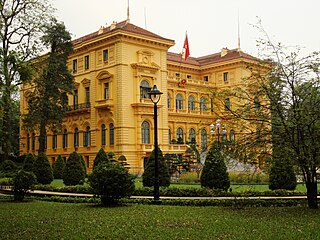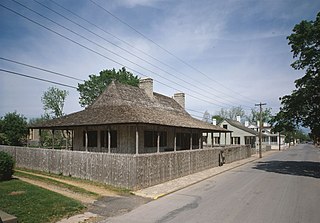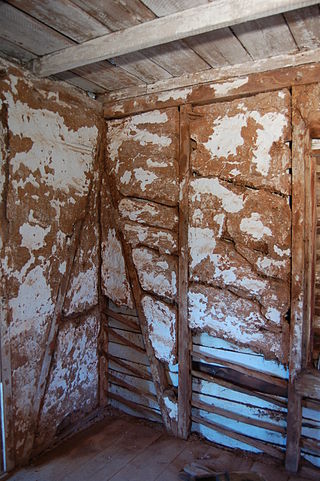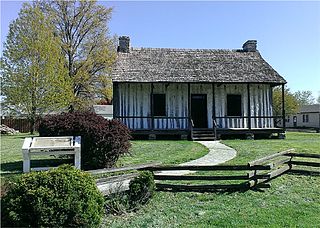
Sainte Genevieve County, often abbreviated Ste. Genevieve County, is a county located in the eastern portion of the U.S. state of Missouri. As of the 2020 census, the population was 18,479. The largest city and county seat is Ste. Genevieve. The county was officially organized on October 1, 1812, and is named after the Spanish district once located in the region, after Saint Genevieve, patroness of Paris, France.

Ste. Genevieve is a city in Ste. Genevieve Township and is the county seat of Ste. Genevieve County, Missouri, United States. The population was 4,999 at the 2020 census. Founded in 1735 by French Canadian colonists and settlers from east of the river, it was the first organized European settlement west of the Mississippi River in present-day Missouri. Today, it is home to Ste. Genevieve National Historical Park, the 422nd unit of the National Park Service.

Lewis Fields Linn was a physician and politician who represented his home state of Missouri in the United States Senate from 1833 to his death.

The Cahokia Courthouse State Historic Site is a reconstructed French-Canadian structure built about 1740 at what is now 107 Elm Street, Cahokia Heights, Illinois. At various times it has served as a house and as a courthouse. It is currently interpreted to resemble its appearance about 1800 as a frontier courthouse of the Northwest Territory. The courthouse was listed on the National Register of Historic Places on November 9, 1972.

French colonial architecture includes several styles of architecture used by the French during colonization. Many former French colonies, especially those in Southeast Asia, have previously been reluctant to promote their colonial architecture as an asset for tourism; however, in recent times, the new generation of local authorities has somewhat "embraced" the architecture and has begun to advertise it. French Colonial architecture has a long history, beginning in North America in 1604 and being most active in the Western Hemisphere until the 19th century, when the French turned their attention more to Africa, Asia, and the Pacific.

Poteaux-sur-sol is a style of timber framing in which relatively closely spaced posts rest on a timber sill. Poteaux-en-terre and pieux-en-terre are similar, but the closely spaced posts extend into the ground rather than resting on a sill on a foundation, and therefore are a type of post in ground construction. Poteaux-sur-sol is similar to the framing style known in the United Kingdom as close studding. Poteaux-sur-sol has also, confusingly, been used for other types of timber framing which have a sill timber such as post-and-plank, but this is considered incorrect by some scholars.
Pierrotage is a half-timbered timber framing technique in which stone infill is used between posts. It was used in France and by French settlers in French Canada and Upper Louisiana.

The Louis Bolduc House, also known as Maison Bolduc, is a historic house museum at 123 South Main Street in Ste. Geneviève, Missouri. It is an example of poteaux sur solle ("posts-on-sill") construction, and is located in the first European settlement in the present-day state of Missouri. The first historic structure in Ste. Genevieve to be authentically restored, the house is a prime example of the traditional French Colonial architecture of the early 18th century in North America and was designated in 1970 as a National Historic Landmark.

The Ste. Genevieve National Historical Park, established in 2020, consists of part or the whole of the area of the Ste. Genevieve Historic District, which is a historic district encompassing much of the built environment of Ste. Genevieve, Missouri, United States. The city was in the late 18th century the capital of Spanish Louisiana, and, at its original location a few miles south, capital of French Louisiana as well. A large area of the city, including fields along the Mississippi River, is a National Historic Landmark District designated in 1960, for its historically French architecture and land-use patterns, while a smaller area, encompassing the parts of the city historically important between about 1790 and 1950, was named separately to the National Register of Historic Places in 2002.

The Felix Vallé House State Historic Site is a state-owned historic preserve comprising the Felix Vallé House and other early 19th-century buildings in Ste. Genevieve, Missouri. It is managed by the Missouri Department of Natural Resources.

The Guibourd House, also known as La Maison de Guibourd, is an example of poteaux-sur-solle sealed with bouzillage construction. The structure was built around 1806 and was the home of Jacques Jean Rene Guibourd and his family.

Bousillage is a mixture of clay and grass or other fibrous substances used as the infill (chinking) between the timbers of a half-timbered building. This material was commonly used by 18th-century French colonial settlers in the historical New France region of the United States and is similar to the material cob and adobe. In French torchis has the same meaning or the meaning of a loaf of this material.

Ste. Genevieve Memorial Cemetery in Ste. Genevieve, Missouri, United States is a contributing site to both the Ste. Genevieve Historic District, and the associated National Landmark District.

A post in ground construction, also called earthfast or hole-set posts, is a type of construction in which vertical, roof-bearing timbers, called posts, are in direct contact with the ground. They may be placed into excavated postholes, driven into the ground, or on sills which are set on the ground without a foundation. Earthfast construction is common from the Neolithic period to the present and is used worldwide. Post-in-the-ground construction is sometimes called an "impermanent" form, used for houses which are expected to last a decade or two before a better quality structure can be built.

The Amoureux House, sometimes called the Beauvais–Amoureux House, is in Ste. Geneviève, Missouri. It was built in 1792 by Jean-Baptiste St. Gemme Beauvais II who moved from Kaskaskia, Illinois. In 1852, it was purchased by Benjamin C. Amoureux, who immigrated to the United States from France.
St. Michel is an abandoned village located in Madison County, Missouri, United States. St. Michel is now incorporated into Fredericktown.

The Pierre Martin House is a single-family French Colonial House and historic site in East Carondelet, Illinois about 1.5 miles (2.4 km) East of the Mississippi River. The house, built circa 1790, is owned by the Illinois Historic Preservation Agency. and located at the intersection of First Street and Old Route 3 in North Dupo.

The Jonathan Barnes House is a historic house on North Street in Hillsborough, New Hampshire. Built about 1775, it is locally distinctive as one of only a few colonial-era houses, and is a well-preserved example of Georgian styling. It has also seen a number of socially significant uses, serving at times as a tavern, library, music school, and fraternal lodge. Surviving interior architectural details provide a significant view into the history of tavern architecture. The house was listed on the National Register of Historic Places in 1982.

Rockford Historic District is a national historic district located at Rockford, Surry County, North Carolina. The district encompasses 12 contributing buildings in the central business district of Rockford. They were primarily built between about 1790 and 1930 and include notable examples of Federal and Greek Revival architecture. Notable buildings include the Methodist Church (1912), former courthouse, York Tavern, Old Post Office, R. H. Clark's Store, the Tobacco Factory, the Grant-Burrus Hotel, and the former Masonic Lodge building.
























